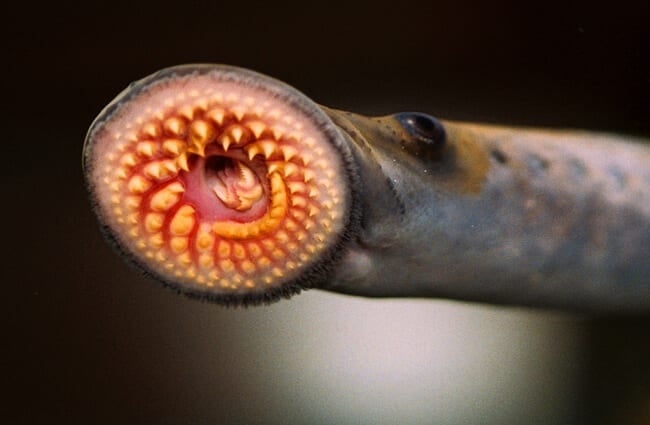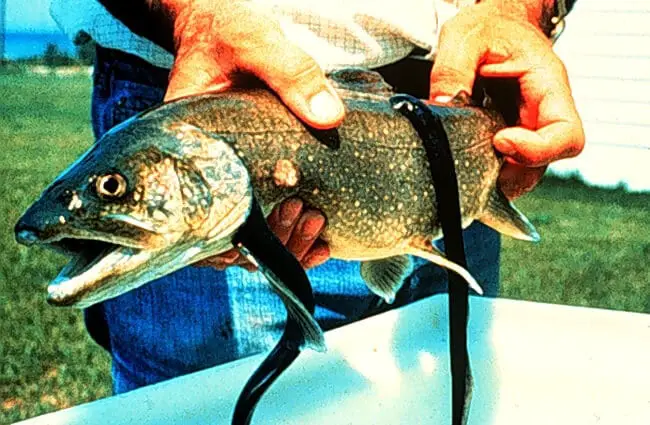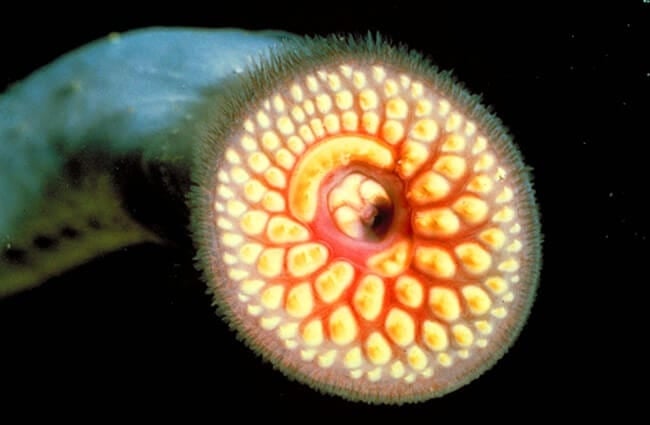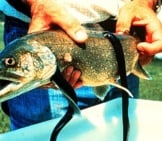Lampreys are eel-like jawless fish that are related to hagfish. They are sometimes referred to as “lamprey eels,” but they are not eels, nor are they related to them. There are over 38 different species of lampreys, and most are easily recognizable. This creature’s primary distinguishing characteristic is its funnel-shaped mouth lined with sharp teeth. Read on to learn about the lamprey.
Description of the Lamprey
These fish look quite similar to eels in body shape. They have elongated, round bodies with a pair of eyes set on either side of their head. Unlike their hagfish cousins, lampreys have two elongated dorsal fins on their backs, close to their caudal (tail) fin. Their mouths are the epitome of nightmare fuel. They are round, and lined with rows upon rows of sharp, inward-facing teeth.
Interesting Facts About the Lamprey
Unless you happen to find one latched onto you, or you are gazing into it’s toothy mouth, lampreys are relatively innocuous creatures to humans. As with any potentially scary creature, it is important to learn more about them before vilifying them.
- Blood-Sucker – That toothy, funnel-like mouth isn’t just for show. These parasitic carnivores are known for not only biting, but actually boring into the skin of their prey to suck their blood. They will feed in this fashion on fish or marine mammals.
- Family Matters – As terrifying as the idea of a creature boring into your skin may be, this isn’t the reality for all lamprey species. In fact, of the 38 different known species, only 18 are carnivorous and feed in this fashion.
- Hunger Strike – Interestingly, the species that do not feed by sucking the blood from other creatures don’t feed at all. After their initial larval stage, the non-carnivorous lampreys metamorphose, spawn, and die shortly after.
- Anadromous – Those that do feed after their larval stage do so in saltwater environments. They migrate from freshwater larval habitats to the ocean, this is called an “anadromous lifestyle.” Depending on the species, they may spend as long as four years in the ocean before returning to freshwater to spawn. After spawning, both the male and female will die.
Habitat of the Lamprey
The habitat choice of these creatures depends on the stage in their life cycle. While they are in the larval stage they will live in streams, lakes, and rivers. Most remain in areas with soft sediment, like mud, so that they can hide from predators. As adults carnivorous species will live in the open ocean, and non-carnivorous species remain in freshwater habitats.
Distribution of the Lamprey
Different species of lampreys have different distribution ranges. Freshwater species that do not exhibit a carnivorous phase will usually remain in close proximity to the area they were born. With such a wide variety of species, these creatures have quite varied ranges.
The Chilean lamprey is native only to Southern Chile, while the pouched lamprey can live in Chile, Argentina, New Zealand, and parts of Australia. There are a number of species native to Australia, the United States, Greece, Mexico, the Arctic Circle, Italy, Korea, Germany, other parts of Europe, and more.
Diet of the Lamprey
For carnivorous species, the primary food source is blood. This is called a “hematophagous diet.” They will feed on a wide variety of freshwater and saltwater fish species.
Some commonly parasitized prey includes herring, trout, mackerel, salmon, sharks, and marine mammals. They latch on to their prey using their suction-cup like mouth and scrape away the skin. Especially with smaller fish species, this can eventually injure or kill the host.
Lamprey and Human Interaction
Some species have been accidentally introduced as an invasive species in the North American Great Lakes. They feed heavily on native fish species, causing damage and population decline. Some species of parasitized fish, like the lake trout, have high commercial value.
This means that not only are the lampreys damaging the native populations, but also the local economy. There are a number of initiatives to reduce the invasive lamprey population, including the introduction of sterilized males, and implementation of pheromones.
Domestication
No species of lamprey has been domesticated in any way.
Does the Lamprey Make a Good Pet
No, lampreys would not make good pets because they must feed off of live fish and would be difficult to care for. The non-carnivorous species do not have long lifespans. Some invasive species are illegal to own as pets because of the danger they pose to natural habitats.
Lamprey Care
Different species of lampreys have very different needs. The larval stage must move from freshwater to saltwater in anadromous species, which makes them difficult to breed. The freshwater species do not live for long periods once they metamorphose.
Carnivorous species live in saltwater conditions, but must move to freshwater in order to breed. This makes it quite difficult for them to reproduce in aquariums.
Behavior of the Lamprey
These creatures do not have intricate and complex behavior. Members of the carnivorous species spend their time locating a host and feeding off of it until the host dies. Once they are ready to breed, they migrate back to their birthplace, spawn, and die. Members of the non-carnivorous species remain at their birthplace and do not feed after they metamorphose. Instead, they spawn immediately and die.
Reproduction of the Lamprey
Spawning occurs at the birth site of most species, and all species reproduce in freshwater environments. Adults create rock nests on the riverbed, called “redds.” The male and female position themselves above the nest and release their eggs and sperm.
They will both die shortly after breeding. Larvae, known as “ammocoetes,” hatch from the eggs. The ammocoetes burrow into the mud and filter feed until they are ready to metamorphose into adults.











![Red Angus Closeup of a beautiful Red Angus cowPhoto by: U.S. Department of Agriculture [pubic domain]https://creativecommons.org/licenses/by/2.0/](https://animals.net/wp-content/uploads/2020/03/Red-Angus-4-238x178.jpg)












![Red Angus Closeup of a beautiful Red Angus cowPhoto by: U.S. Department of Agriculture [pubic domain]https://creativecommons.org/licenses/by/2.0/](https://animals.net/wp-content/uploads/2020/03/Red-Angus-4-100x75.jpg)

